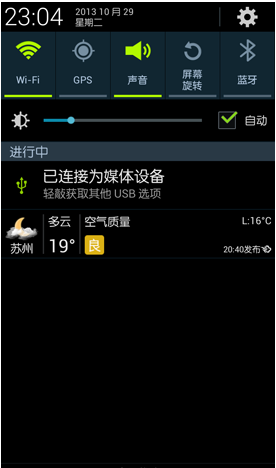Service无法自行启动,访问者启动它的方式分为两种,即startService(非绑定式)和bindService (绑定式),相关介绍如下:
* startService:即非绑定式。访问者使用这种方式启动service后,service将不受访问者控制,也无法与访问者进行数据通信,它会无限地运行下去,必须调用stopSelf()方法或者其他组件(包括访问者)调用stopService()方法来停止。它的生命周期:onCreate->onStartCommand()->……>onDestory(),其中,onCreate用于初始化工作,多次调用startService启动同一个服务,onCreate方法只会被调用一次,onStartCommand会被调用多次,onDestory在销毁时也只会被调用一次。
* bindService:即绑定式。访问者使用这种方式启动service后,被启动的service受访问者的控制,访问者将通过一个IBinder接口的对象与被绑定的service进行通信,并且可以通过unbindService()方法随时关闭service。一个service可以同时被多个访问者绑定,只有当多个访问者都主动解除绑定关系之后,系统才会销毁service。它的生命周期:onCreate->onBind->....>onUnbind->onDestory,其中,onBind用于返回一个通信对象(IBinder)给访问者,访问者可以通过该IBinder对象调用service的相关方法。当多个访问者绑定同一个service时,onCreate只会被调用一次,onBind、unOnbind方法会被调用与访问者数目相关的次数,onDestory在销毁时只会被调用一次。
startService和bindService,用哪个好?
开启服务时,它们与activity之间的关系:
1、startService开启服务以后,与activity就没有关联,不受影响,独立运行。
2、bindService开启服务以后,与activity存在关联,退出activity时必须调用unbindService方法,否则会报ServiceConnection泄漏的错误。
因此,根据实际需求使用最好。
Service类若调用startService启动时,有个生命周期方法叫onStartCommand,这个方法有一个整型的返回值:START_STICKY_COMPATIBILITY
START_STICKY
START_NOT_STICKY
START_REDELIVER_INTENT
默认情况下,当我们的服务因为系统内存吃紧或者其他原因被异常终止时,系统会尝试在某个时刻重新启动服务,
START_NOT_STICKY:服务不会重新创建,除非你再次调用startService
START_STICKY / START_STICKY_COMPATIBILITY:服务重新创建并启动,依次回调onCreate、onStartCommand,如果没有新的intent传给此service,onStartCommand接受的将是一个空的intent。
START_STICKY_COMPATIBILITY:START_STICKY的兼容版本,2.0之下使用,它不保证一定调用onStartCommand.
START_REDELIVER_INTENT:服务重新创建并启动,依次回调onCreate,onStartCommand,并且会把最后一次传给此服务的intent重新发给onStartCommand。
PS:
1、系统默认是START_STICKY。另外,为app保活着想,也应该设为START_STICKY
2、如果一个service被startService启动,然后其他组件再执行bindService绑定该service,service的onCreate不会再被回调,而是直接回调onBind方法;当该组件unBindService时,service的onUnbind方法被回调,但是service不会被销毁,直到自己调用stopSelf方法或者其他组件调用stopService方法时才会被销毁。
1. Service分类

2.2 可通信的服务Service
- 接下来将在Service的基础用法上,增设“与Activity通信”的功能,即使用绑定Service服务(Binder类、bindService()、onBind()、unbindService()、onUnbind())
- 步骤1:在新建子类继承Service类,并新建一个子类继承自Binder类、写入与Activity关联需要的方法、创建实例
public class MyService extends Service {
private MyBinder mBinder = new MyBinder();
@Override
public void onCreate() {
super.onCreate();
System.out.println("执行了onCreat()");
}
@Override
public int onStartCommand(Intent intent, int flags, int startId) {
System.out.println("执行了onStartCommand()");
return super.onStartCommand(intent, flags, startId);
}
@Override
public void onDestroy() {
super.onDestroy();
System.out.println("执行了onDestory()");
}
@Nullable
@Override
public IBinder onBind(Intent intent) {
System.out.println("执行了onBind()");
//返回实例
return mBinder;
}
@Override
public boolean onUnbind(Intent intent) {
System.out.println("执行了onUnbind()");
return super.onUnbind(intent);
}
//新建一个子类继承自Binder类
class MyBinder extends Binder {
public void service_connect_Activity() {
System.out.println("Service关联了Activity,并在Activity执行了Service的方法");
}
}
}
- 步骤2:在主布局文件再设置两个Button分别用于绑定和解绑Service
<?xml version="1.0" encoding="utf-8"?>
<RelativeLayout xmlns:android="http://schemas.android.com/apk/res/android"
xmlns:tools="http://schemas.android.com/tools"
android:layout_width="match_parent"
android:layout_height="match_parent"
android:paddingBottom="@dimen/activity_vertical_margin"
android:paddingLeft="@dimen/activity_horizontal_margin"
android:paddingRight="@dimen/activity_horizontal_margin"
android:paddingTop="@dimen/activity_vertical_margin"
tools:context="scut.carson_ho.demo_service.MainActivity">
<Button
android:layout_centerInParent="true"
android:id="@+id/startService"
android:layout_width="wrap_content"
android:layout_height="wrap_content"
android:text="启动服务" />
<Button
android:layout_centerInParent="true"
android:layout_below="@+id/startService"
android:id="@+id/stopService"
android:layout_width="wrap_content"
android:layout_height="wrap_content"
android:text="停止服务" />
<Button
android:layout_centerInParent="true"
android:layout_below="@id/stopService"
android:id="@+id/bindService"
android:layout_width="wrap_content"
android:layout_height="wrap_content"
android:text="绑定服务" />
<Button
android:layout_centerInParent="true"
android:layout_below="@id/bindService"
android:id="@+id/unbindService"
android:layout_width="wrap_content"
android:layout_height="wrap_content"
android:text="解绑服务"
/>
</RelativeLayout>
- 步骤3:在Activity通过调用MyBinder类中的public方法来实现Activity与Service的联系
即实现了Activity指挥Service干什么Service就去干什么的功能
MainActivity.java
public class MainActivity extends AppCompatActivity implements View.OnClickListener {
private Button startService;
private Button stopService;
private Button bindService;
private Button unbindService;
private MyService.MyBinder myBinder;
//创建ServiceConnection的匿名类
private ServiceConnection connection = new ServiceConnection() {
//重写onServiceConnected()方法和onServiceDisconnected()方法
//在Activity与Service建立关联和解除关联的时候调用
@Override
public void onServiceDisconnected(ComponentName name) {
}
//在Activity与Service解除关联的时候调用
@Override
public void onServiceConnected(ComponentName name, IBinder service) {
//实例化Service的内部类myBinder
//通过向下转型得到了MyBinder的实例
myBinder = (MyService.MyBinder) service;
//在Activity调用Service类的方法
myBinder.service_connect_Activity();
}
};
@Override
protected void onCreate(Bundle savedInstanceState) {
super.onCreate(savedInstanceState);
setContentView(R.layout.activity_main);
startService = (Button) findViewById(R.id.startService);
stopService = (Button) findViewById(R.id.stopService);
startService.setOnClickListener(this);
stopService.setOnClickListener(this);
bindService = (Button) findViewById(R.id.bindService);
unbindService = (Button) findViewById(R.id.unbindService);
bindService.setOnClickListener(this);
unbindService.setOnClickListener(this);
}
@Override
public void onClick(View v) {
switch (v.getId()) {
//点击启动Service
case R.id.startService:
//构建启动服务的Intent对象
Intent startIntent = new Intent(this, MyService.class);
//调用startService()方法-传入Intent对象,以此启动服务
startService(startIntent);
break;
//点击停止Service
case R.id.stopService:
//构建停止服务的Intent对象
Intent stopIntent = new Intent(this, MyService.class);
//调用stopService()方法-传入Intent对象,以此停止服务
stopService(stopIntent);
break;
//点击绑定Service
case R.id.bindService:
//构建绑定服务的Intent对象
Intent bindIntent = new Intent(this, MyService.class);
//调用bindService()方法,以此停止服务
bindService(bindIntent,connection,BIND_AUTO_CREATE);
//参数说明
//第一个参数:Intent对象
//第二个参数:上面创建的Serviceconnection实例
//第三个参数:标志位
//这里传入BIND_AUTO_CREATE表示在Activity和Service建立关联后自动创建Service
//这会使得MyService中的onCreate()方法得到执行,但onStartCommand()方法不会执行
break;
//点击解绑Service
case R.id.unbindService:
//调用unbindService()解绑服务
//参数是上面创建的Serviceconnection实例
unbindService(connection);
break;
default:
break;
}
}
}
2.2.2 Demo
carson.ho的Github地址:Demo_for_Service
2.3 前台Service
前台Service和后台Service(普通)最大的区别就在于:
- 前台Service在下拉通知栏有显示通知(如下图),但后台Service没有;

- 前台Service优先级较高,不会由于系统内存不足而被回收;后台Service优先级较低,当系统出现内存不足情况时,很有可能会被回收
2.3.1 具体使用
用法很简单,只需要在原有的Service类对onCreate()方法进行稍微修改即可,如下图:
@Override
public void onCreate() {
super.onCreate();
System.out.println("执行了onCreat()");
//添加下列代码将后台Service变成前台Service
//构建"点击通知后打开MainActivity"的Intent对象
Intent notificationIntent = new Intent(this,MainActivity.class);
PendingIntent pendingIntent = PendingIntent.getActivity(this,0,notificationIntent,0);
//新建Builer对象
Notification.Builder builer = new Notification.Builder(this);
builer.setContentTitle("前台服务通知的标题");//设置通知的标题
builer.setContentText("前台服务通知的内容");//设置通知的内容
builer.setSmallIcon(R.mipmap.ic_launcher);//设置通知的图标
builer.setContentIntent(pendingIntent);//设置点击通知后的操作
Notification notification = builer.getNotification();//将Builder对象转变成普通的notification
startForeground(1, notification);//让Service变成前台Service,并在系统的状态栏显示出来
}
2.3.2 测试结果
运行后,当点击Start Service或Bind Service按钮,Service就会以前台Service的模式启动(通知栏上有通知),如下图
3. 使用场景
各种Service的使用场景请看下图:

Service 与 Thread的区别
- 结论:
Service与Thread无任何关系 - 之所以有不少人会把它们联系起来,主要因为
Service的后台概念
后台:后台任务运行完全不依赖
UI,即使Activity被销毁 / 程序被关闭,只要进程还在,后台任务就可继续运行
- 关于二者的异同,具体如下图:

- 一般会将
Service和Thread联合着用,即在Service中再创建一个子线程(工作线程)去处理耗时操作逻辑,如下代码:
@Override
public int onStartCommand(Intent intent, int flags, int startId) {
//新建工作线程
new Thread(new Runnable() {
@Override
public void run() {
// 开始执行后台任务
}
}).start();
return super.onStartCommand(intent, flags, startId);
}
class MyBinder extends Binder {
public void service_connect_Activity() {
//新建工作线程
new Thread(new Runnable() {
@Override
public void run() {
// 执行具体的下载任务
}
}).start();
}
}
链接:https://www.jianshu.com/p/d963c55c3ab9
链接:https://www.jianshu.com/p/e04c4239b07e
链接:https://blog.csdn.net/andrexpert/article/details/53485360
https://www.jianshu.com/p/d870f99b675c